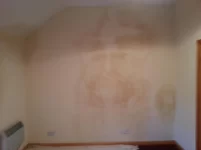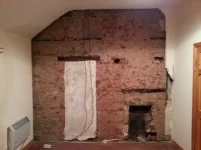I'm getting work done on an old (~100yrs) house. Since the house was renovated about 10 yrs ago there have been increasingly large yellowish / brown damp patches on the bedroom walls (1 wall in each room, mainly where the chimney was covered, some ingress on the cieling and onto side walls).
From reading, these appear to be caused by the hygroscopic salts in the old chimney. As it's a holiday home it can be left for months unheated, unventilated and so was a prime damp magnet. We are now doing it up for rental, installing central heating, ventilation etc. so those issues should be removed.
I have stripped the walls back to the bare brick and am leaving for a while to dry out any moisture in the walls (althought maybe this is a waste as I'm sure the salts will keep attracting the moisture).
In any case I've been told by builders this is rising damp despite being present on the second floor and nothing at all being evident until about 3 feet up the wall. It's also just patchy descolouration, not flaking, no mould. See the photo below.

After stripping back.

What's the best way for me to make sure this won't continue once it's re-plastered? Some sort of mesh membrane?
From reading, these appear to be caused by the hygroscopic salts in the old chimney. As it's a holiday home it can be left for months unheated, unventilated and so was a prime damp magnet. We are now doing it up for rental, installing central heating, ventilation etc. so those issues should be removed.
I have stripped the walls back to the bare brick and am leaving for a while to dry out any moisture in the walls (althought maybe this is a waste as I'm sure the salts will keep attracting the moisture).
In any case I've been told by builders this is rising damp despite being present on the second floor and nothing at all being evident until about 3 feet up the wall. It's also just patchy descolouration, not flaking, no mould. See the photo below.

After stripping back.

What's the best way for me to make sure this won't continue once it's re-plastered? Some sort of mesh membrane?
